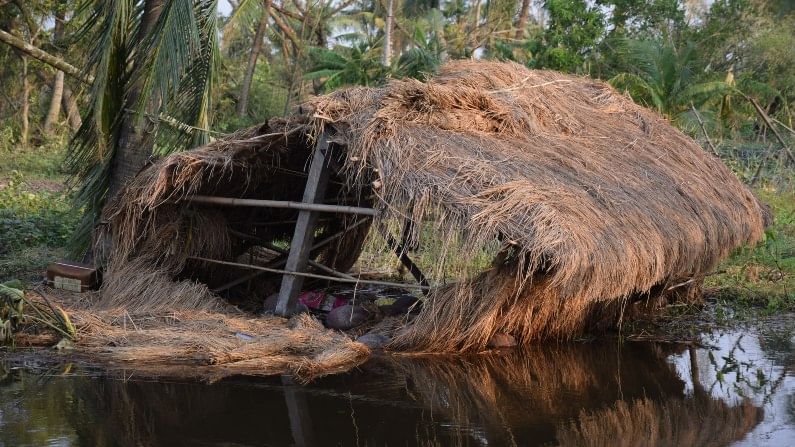Cyclone Tauktae: India's date with cyclones
Cyclone Amphan struck the east coast with unmatched fury a year ago, but it was another name in a long list that has tormented the country in the past few decades

Around 1:30 pm, the winds started howling developing into a whistling sound that one gets to hear in films of natural disasters. The only difference was that it was not done by foley artists in a studio but was the sound of havoc as the clouds and winds conspired, as it were, to wreak havoc on earth.
The winds swept the rains through the gaps in window panes and below doors, flooding well-decorated rooms of upper middle class gentry. Video clips of multi-crore plush apartments in iconic housing projects turning into mini-waterfalls began circulating on social media.
May 20, 2020
It was May 20, 2020. Bengal, along with the rest of the country, was reeling under the effects of one of the strictest lockdowns in the world, when cyclone Amphan struck.
For the next few hours, trees fell like ninepins, electric poles toppled like pawns on a chessboard, overhead power and internet cables snapped like strings and rains turned vast areas of Kolkata into a zone of urban helplessness. Vast areas of south Bengal went under sheets of water as the rains refused to stop and high tides from coastal rivers inundated farmlands ruining crops with surges brackish water.
Wind and water
The winds shook tall buildings with their gale force, shattered windowpanes and snapped all communication and power connection for days. By initial estimates, at least 5,000 trees were uprooted in Kolkata Municipal area alone prompting the government to seek the help of armed forces to clear the roads.
“I still remember it vividly. The power connections had snapped. I was huddled with a couple of neighbours only listening to the sound of lashing rain and fury of the winds,” said Snigdha Ray, a septuagenarian, a resident of south Kolkata, who lives alone.
According to the state government and other bodies, the economic impact exceeded Rs 1 lakh crore, the amount which the administration said the state needed as relief.
1971, Odisha
A super cyclone had hit Paradip in Odisha in October, killing at least 11,000 people. Winds up to 185 km per hour hit the state and caused a lot of damage to houses, crops and livestock.
It was a time when advance warning systems were poorer than they are today.
1977, Andhra Pradesh
The cyclone that formed over the Bay of Bengal, hit Chirala in Prakasam district of Andhra Pradesh. The super cyclonic storm whipped up a 20 feet surge in the coastal areas.
The calamity took the lives of an estimated 10,000 people and 5 lakh cattle. It caused untold misery to the state.
1982, Odisha and Gujarat
About 150 lives were lost when a cyclone hit Paradip of Odisha in May.
Another struck Porbandar in Gujarat in November and about 350 people were killed in that calamity. Both were extremely severe cyclonic storms.
1998, Gujarat
An extremely severe cyclonic storm gathered force with winds reaching about 195 km per hour on June 9. Nearly 1,200 lives were lost and about 1,800 were reported missing.
1999, Odisha
This super cyclone has become a popular reference point for destructive winds. The estimates of fatalities ranged from 25,000 to 30,000 but the Centre out the death toll at close to 9,900. A majority of the deaths were caused by the huge storm surge.
Around 16 lakh houses were flattened and about 20,000 flood embankments were washed away.
The total damage was estimated at $4.44 billion.
2009, West Bengal
On May 23, the storm left lakh homeless and hundreds dead in West Bengal. A lot of destruction was caused in Bangladesh too. The official figure of fatalities in India was 149.
The storm surge sent vast areas in the Sundarbans under brackish water and made them unfit for cultivation for years.
River dykes erected in villages for thousands of kms were washed away making the villages vulnerable to high tides and low tides in the coastal rivers.
The attendant rains were so heavy that more than 600 km to the north, in the hills of Darjeeling, they triggered landslides killing 22 people.
2013, Odisha
It originated in the Gulf of Thailand on October 4. Armed with an early warning, the Odisha and Andhra Pradesh governments evacuated about 5.5 lakh people – one of the largest evacuations in India – to safer places away from the coastline.
Gusts of wind with speed up to 260 km per hour were recorded. The total losses were estimated at $4.26 billion.
2014, Andhra Pradesh
Hudhud was an extremely severe cyclonic storm. It caused a lot of damage not only in India but also in Nepal where it caused heavy snowfall.
It hit the coastline near Visakhapatnam on October 12 and peak wind speed reached 185 km per hour.
The districts of Srikakulam and Vizianagaram suffered heavy damage. Damages were estimated to be about $3.58 billion.
2015, Tamil Nadu
A deep depression in the Bay of Bengal triggered flooding in the state, which many describe as the worst in a century. It killed about 500 people.
The total damage was estimated to be around $15 billion.
2019, Odisha
This extremely severe cyclone named Phani hit the coastal area in Puri on May 3 with a windspeed of 215 km per hour. It is perhaps the strongest cyclone recorded in the country.
The damages were estimated to be about $8.1 billion.